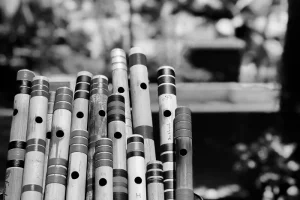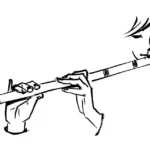Indian bamboo flute is made from bamboo harvested in the mountains of north eastern states. From there it travels to artists in various parts of the country to be converted into one of the many types of flutes. There are two main traditions of music in India outside of regional folk music that use flute as an important instrument, Hindustani and Carnatic. The north Indian Hindustani tradition uses a 6 hole bamboo flute called a Bansuri and the south Indian carnatic tradition uses an 8 hole bamboo flute called venu.
For the purpose of this article, we will consider that you are here to learn about the bansuri. There are 27 different sizes of bansuris ranging from base to treble that a player can choose from. Each type of flute determines the scale of the SA sound (produced by closing the first 3 holes of the bansuri). The longer flutes produce base sounds while the smaller flutes produce treble sound.
If you are an absolute beginner, a G sharp base flute for beginners would be ideal for you. It is easy to produce sound and is of the right difficulty to get used to the nuances of using the instrument.
If you are looking for your child, who is less than 12 yrs, C scale middle flute for beginners will serve the purpose to start. You can slowly graduate to G-sharp base flute.
We then graduate to an E flute which is typically what is used in performances. If you are keen to hone your skills in playing Bansuri, The Mystic Bamboo Academy run by Shri Himanshu Nanda ji, a senior student of Shri Hari Prasad Chaurasia ji offers online flute lessons for intermediate and beginner students.
Here are a few tips to pick the right bansuri for you if you want to pursue this art:
Know About the Makers
There are a number of companies with web presence that let you buy different types of flutes. There are also traditional artisans who are in the profession of turning a natural bamboo into a melodious bansuri. These days, the makers offer online consultations to discuss your specific need and provide advice on which type of bansuri to buy.
The first step to getting the right flute is to find the right maker. Do your research well. You can also get the list of all famous makers in The Mystic Bamboo website. They make bansuris using the traditional methods passed on from generation to generation.
Cheap VS Expensive
While you can learn to play a bansuri on any flute, if you are interested in pursuing it long term, you are better off finding a flute that is well made by professionals and will last. Natural bamboo can crack under pressure and react to weather conditions. Unless you buy one that is made by reputed makers, your bamboo may not last.
Every bansuri is unique given it is made from natural bamboo. When you start learning with a bansuri you develop a bond with it. You learn how to make music from it and it learns to align to your body. Changing flutes frequently will reset the learning process which is another reason why you should not go for any cheap flute that is available for investing in long term learning.
Well Tuned Flute
For the intermediate and advanced students, it is always good to go to the maker personally to choose your beloved flute. When buying a new bansuri, make sure that it is well tuned. Use a tuner or a tanpura to see that the bansuri is correctly tuned. There are a number of applications on Android and iOS that will help you with tuning the bansuri. A bansuri that is off tune can be very difficult to adjust and play.
Different Types of Bansuri for Different Performances
Different bansuris are built to play at different scales. Pick the right bansuri based on your need. E base flute is the most common flute that is used for classical performance. It is preferred for its deep sound that is well suited to be played in large halls packed with audience. It also is preferred for the way it emotes the nuances of the classical music. If you have small fingers, choosing a F-sharp base will also work.
Testing the Bansuri
When testing the bansuri, first play the SA sound and observe the right tuning and hissing noise it makes. Some of the hissing gets fixed with practice but some bansuris have a flaw in how they made which results in the hissing sound. After that, test playing the full octave and notice if all the notes are accurate.
Go and then play the alankaras, especially the ones where you skip notes. This will show if the holes are in places that is easy for you to play. If you are able to play these correctly and comfortably and the bansuri is well tuned, you found your bansuri or your bansuri has found you.
Conclusion
We are excited that you are keen to learn this ancient instrument. Bansuri music is one of the most beautiful sounds nature has gifted us and we at The Mystic Bamboo Academy will be thrilled to help you along in this journey. Do not hesitate to get in touch with us either to get advice on the right bansuri for you or for online classes for intermediate and beginner students.




